
Top 10 historical sites for tourists in Spain are going to be discussed in this article. Explore iconic landmarks like the Alhambra, Segovia Aqueduct, and Sagrada Familia for a truly enriching experience.
1. Alhambra Spain –
2. Sagrada Familia Spain –
3. Mezquita-Catedral de Córdoba Spain –
4. El Escorial Spain –
5. Roman Theatre of Mérida Spain –
6. Alcazar of Segovia Spain –
7. Guggenheim Museum Bilbao Spain –
8. Toledo Cathedral Spain –
9. Roman Aqueduct of Segovia Spain –
10. Alcazaba of Málaga Spain –
1. Alhambra Spain –
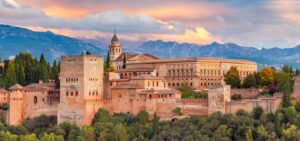
The Alhambra, located in Granada, Spain, is a majestic fortress complex and a prime example of Moorish architecture.
It stands as a testament to the rich history and cultural fusion that characterized medieval Spain.
Constructed in the mid-13th century by the Nasrid Emir Mohammed ben Al-Ahmar, the Alhambra was expanded and modified over the centuries, reflecting the artistic and architectural influences of the Muslim rulers who called it home.
For tourists, the Alhambra offers an unforgettable journey through history.
The architects divided the complex into three main sections: the Alcazaba (the military fortress), the Nasrid Palaces, and the Generalife (the summer palace and gardens).
The complex is divided into three main sections: first, the Alcazaba (the military fortress); second, the Nasrid Palaces; and finally, the Generalife (the summer palace and gardens).
Each section has its unique charm and significance.
The Nasrid Palaces are the heart of the Alhambra; moreover, they showcase exquisite stucco work, intricate tile mosaics, and stunning wooden ceilings.
Highlights include the Hall of the Ambassadors and the Court of the Lions, with its famous fountain surrounded by 12 marble lions.
These palaces are a visual feast, illustrating the sophistication and artistic excellence of the Nasrid dynasty.
The Generalife, with its lush gardens and tranquil water features, not only offers a serene contrast to the grandeur of the Nasrid Palaces, but it also provides a peaceful retreat for visitors.
It was a place for the rulers to relax and escape the formalities of court life. The views from the Generalife over the city of Granada and the Sierra Nevada mountains are breathtaking.
2. Sagrada Familia Spain –
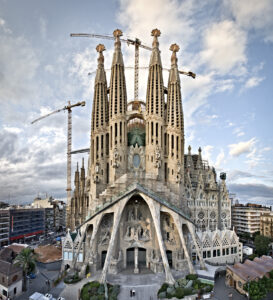
The Sagrada Familia, located in Barcelona, Spain, is an architectural masterpiece and an iconic symbol of the city.
Designed by the renowned architect Antoni Gaudí, this basilica is not only a UNESCO World Heritage Site but also a testament to Gaudí’s unique vision and genius.
Construction began in 1882; however, the project remains unfinished, and ongoing work is expected to continue for several more years.
Tourists visiting the Sagrada Familia are immediately struck by its awe-inspiring facades and towering spires.
The basilica features three grand facades: the Nativity Facade, the Passion Facade, and the Glory Facade, each depicting different aspects of Christ’s life.
The Nativity Facade, completed during Gaudí’s lifetime, is particularly detailed, showcasing intricate carvings that celebrate the birth of Jesus.
Inside, the Sagrada Familia not only offers a mesmerizing experience with its vast, open nave, but it also features striking columns that resemble a forest canopy.
Gaudí’s innovative use of natural light is evident in the colorful stained-glass windows that bathe the interior in a kaleidoscope of colors.
The play of light and shadow not only creates a spiritual and serene atmosphere, but it also invites visitors to pause and reflect.
One of the highlights for tourists is the opportunity to ascend the towers.
From the top, visitors are rewarded with panoramic views of Barcelona, providing a unique perspective of the city and the basilica’s intricate details.
Advance tickets are highly recommended due to the Sagrada Familia’s popularity.
Guided tours are available, offering deeper insights into the history, symbolism, and ongoing construction of this extraordinary basilica.
A visit to the Sagrada Familia is a must for anyone traveling to Barcelona, offering a profound appreciation for Gaudí’s unparalleled creativity and architectural legacy..
3. Mezquita-Catedral de Córdoba Spain –
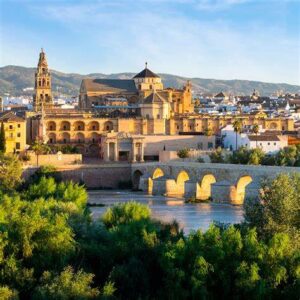
The Mezquita-Catedral de Córdoba, also known as the Mosque-Cathedral of Córdoba, is one of the most notable historical sites in Spain for tourists and architectural treasures.
Located in the heart of Córdoba, Andalusia, this UNESCO World Heritage Site epitomizes the cultural and religious transformations that the region has experienced over the centuries.
Built as a mosque in the 8th century during the Umayyad dynasty, the Mezquita became both a place of worship and a symbol of Islamic art and architecture.
Visitors are immediately captivated by the vast prayer hall, which features a forest of over 850 columns made from jasper, onyx, marble, and granite.
These columns support stunning double-tiered arches, creating a mesmerizing and almost hypnotic visual effect.
The red and white striped arches are particularly iconic and have become a symbol of the city.
Following the Christian Reconquista in 1236, the mosque was consecrated as a cathedral. In the 16th century, a Renaissance-style nave was added in the center of the existing mosque structure.
The Mezquita-Catedral’s unique combination of Islamic and Christian architectural elements showcases both the fascinating coexistence of these religions and the rich history of their cultural collaboration.
Guests at the complex can discover many highlights, including the intricately adorned mihrab (prayer niche), the ornate Baroque altarpiece in the cathedral’s nave, and the peaceful Courtyard of the Orange Trees (Patio de los Naranjos).
A visit to the Mezquita-Catedral de Córdoba offers a profound journey through history, showcasing the harmonious blend of artistic styles and religious traditions.
To make the most of your visit, consider taking a guided tour to gain deeper insights into its historical significance and architectural marvels.
The Mezquita-Catedral is not just a building but a testament to the diverse cultural heritage that defines Córdoba.
4. El Escorial Spain –
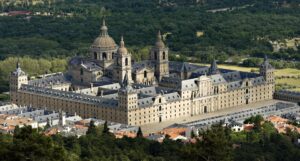
El Escorial is a monumental complex located in the town of San Lorenzo de El Escorial near Madrid, a symbol of Spanish Renaissance architecture and one of the most important historical sites for tourists in the Kingdom of Spain.
Constructed between 1563 and 1584 under the reign of King Philip II, El Escorial was designed to serve multiple functions: a royal palace, a monastery, a basilica, a library, and a royal mausoleum.
El Escorial offers tourists a rich tapestry of history, art, and architecture.
The imposing facade of the complex not only immediately commands attention, but also reflects the austere and grandiose vision of King Philip II.
Inside, visitors can explore the stunning basilica, which features a majestic dome and an impressive collection of religious art.
The basilica’s high altar, adorned with bronze statues and a magnificent tabernacle, is particularly noteworthy.
One of the highlights of El Escorial is, in fact, the Royal Pantheon, which serves as the final resting place of many Spanish monarchs.
The Pantheon of the Kings, with its lavish marble and bronze decoration, not only provides a fascinating insight into the royal burial traditions, but it also highlights the grandeur associated with these ceremonies.
Adjacent to the pantheon, the Hall of Battles features large frescoes depicting significant military victories of the Spanish Empire.
The complex features a significant library, renowned for its priceless manuscripts, ancient maps, and illuminated texts of historical importance.
The frescoes on the library’s vaulted ceiling are not only a visual delight, but they also illustrate the allegories of knowledge and learning.
The meticulously maintained gardens, along with the serene courtyard, not only offer a tranquil space for reflection but also provide an inviting area for leisure.
5. Roman Theatre of Mérida Spain –
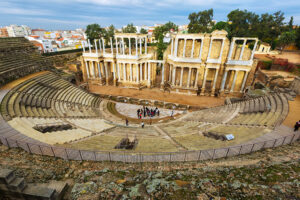
The Roman Theatre of Mérida is one of the historical sites for tourists, located in the historic city of Mérida, Spain, is a magnificent relic from the Roman Empire and a testament to the architectural prowess of ancient Rome.
Roman consul Marcus Vipsanius Agrippa built the theatre around 15 BCE, and it stands among Europe’s best-preserved Roman structures, included in the UNESCO World Heritage Site of Mérida.
Architects originally designed the theatre to accommodate approximately 6,000 spectators, and performers used it for a variety of events, from dramatic plays to political gatherings.
The designers divided the semicircular seating area, or cavea, into three sections, which provides a clear view of the stage and ensures that every seat in the house has excellent sightlines.
The most striking feature of the theatre is, without a doubt, its stunning stage facade, or scaenae frons; furthermore, it features two levels of Corinthian columns made of marble and granite, which are adorned with intricate carvings and statues of deities and imperial figures.
This grand backdrop provided an imposing and decorative setting for performances.
One of the highlights of a visit is the annual Mérida Classical Theatre Festival; in fact, it brings the ancient theatre back to life with performances of classical plays, thereby attracting audiences from around the world.
The festival is a unique opportunity to experience the theatre as it was originally intended, filled with the sounds and energy of live performances.
Exploring the Roman Theatre of Mérida not only offers a deep dive into the cultural and social life of ancient Rome, but it also provides valuable insights into the architectural advancements of the time.
6. Alcazar of Segovia Spain –
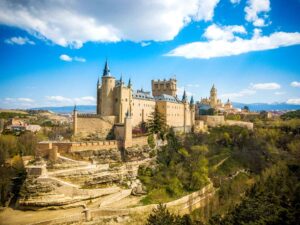
The Alcazar of Segovia is one of the historical sites for tourists in Spain.
The Alcazar of Segovia, perched on a rocky crag overlooking the confluence of the Eresma and Clamores rivers, is one of Spain’s most distinctive and picturesque castles.
The fairytale-like Alcazar inspired legends and Disney’s Cinderella Castle, while originally serving as a fortress, royal palace, military academy, and prison.
Tourists visiting the Alcazar immediately notice its stunning architecture, featuring a blend of Romanesque, Gothic, and Moorish influences.
The castle’s ship-like shape is accentuated by slender towers and steep slate roofs, complemented by the iconic Tower of John II, which offers breathtaking panoramic views of Segovia and its landscape.
Climbing the 152 steps to the top is not only a rewarding experience but also an excellent opportunity for those seeking a bird’s-eye view of the region.
The Alcazar’s stunning interiors feature the Hall of the Kings, showcasing friezes of 52 Spanish monarchs, and the Throne Room with its intricate Mudejar ceiling.
The Hall of the Galley features a magnificent wooden ceiling resembling an inverted ship’s hull; furthermore, this design serves as a nod to the Alcazar’s nautical inspiration.
The castle also houses an intriguing collection of medieval armor and weaponry in its museum, providing a glimpse into its storied military past.
The Chapel, with its beautiful altarpiece and serene ambiance, adds to the historical and cultural depth of the site.
A visit to the Alcazar of Segovia not only offers a captivating journey through Spain’s rich history, but it also provides an opportunity to explore its stunning architecture and picturesque surroundings.
Experts recommend guided tours to fully appreciate the architectural marvels and historical significance of this iconic fortress.
7. Guggenheim Museum Bilbao Spain –
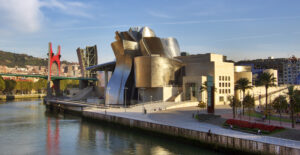
The Guggenheim Museum Bilbao, located in Spain, is a renowned architectural masterpiece that attracts tourists from around the world.
Designed by the acclaimed architect Frank Gehry, the museum’s unique and futuristic design has not only made it an iconic landmark in the city of Bilbao, but it has also attracted visitors from around the world.
Visitors to the Guggenheim Museum Bilbao will find themselves captivated by its striking titanium-clad exterior, which reflects the surrounding landscape and changes appearance with the time of day and weather conditions.
The museum’s interior is equally impressive, with spacious galleries that showcase a diverse collection of contemporary art and exhibitions.
Art enthusiasts will appreciate the museum’s permanent collection, which includes works by renowned artists such as Jeff Koons, Richard Serra, and Yoko Ono.
In addition to its permanent collection, the Guggenheim Museum Bilbao also hosts temporary exhibitions that feature cutting-edge contemporary art from around the world.
For tourists looking to learn more about the museum and its architecture, guided tours are available in multiple languages.
These tours provide insight into the history of the museum; in addition, they explore its design process and highlight the artists featured in its collections.
After exploring the museum, visitors can relax and enjoy a meal at the museum’s on-site restaurant, which offers stunning views of the Nervion River.
The Guggenheim Museum Bilbao also features a museum shop where visitors can purchase unique souvenirs and gifts to commemorate their visit.
Overall, the Guggenheim Museum Bilbao is a must-visit destination for tourists seeking a cultural and artistic experience in Spain.
Its innovative design, world-class art collection, and engaging exhibitions make it a truly unforgettable destination for art lovers and travelers alike.
8. Toledo Cathedral Spain –
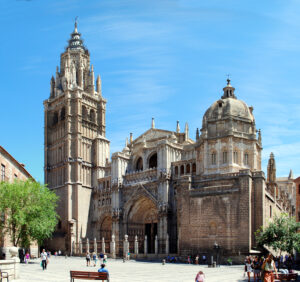
The Toledo Cathedral, located in Spain, is one of the historical sites and a magnificent example of Gothic architecture and a must-visit destination for tourists seeking to explore the rich history and culture of Spain.
Built over several centuries, the cathedral is not only a testament to the skill of the artisans but also to their craftsmanship in the construction process.
Visitors to the Toledo Cathedral will be awe-struck by its grandeur and beauty.
The cathedral’s exterior features intricate stone carvings, towering spires, and ornate facades; furthermore, these elements collectively showcase the architectural mastery of the medieval craftsmen.
Inside, visitors will find a treasure trove of religious art, including stunning stained glass windows, elaborate altarpieces, and intricately carved choir stalls.
One of the highlights of the Toledo Cathedral is the High Altar, a masterpiece of Spanish Renaissance art created by the renowned artist El Greco.
The cathedral also houses a collection of priceless religious relics, including the Crown of Thorns and a fragment of the True Cross.
Guided tours of the Toledo Cathedral are available for tourists looking to learn more about its history and significance.
These tours provide insight into the cathedral’s construction; additionally, they highlight its architectural features and showcase the religious art contained within its walls.
After exploring the cathedral, visitors can wander through the charming streets of Toledo, a UNESCO World Heritage Site known for its well-preserved medieval architecture and rich cultural heritage.
The Toledo Cathedral is a must-see attraction for tourists seeking to immerse themselves in the history and beauty of Spain.
9. Roman Aqueduct of Segovia Spain –
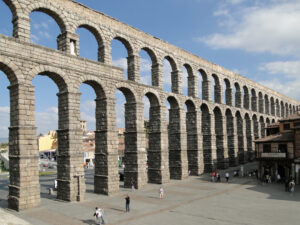
The Roman Aqueduct of Segovia is one of the historical sites for tourists, located in Spain, is a remarkable ancient structure that stands as a testament to the engineering prowess of the Roman Empire.
Built in the 1st century AD, this aqueduct is one of the best-preserved Roman engineering feats in the world and is a UNESCO World Heritage Site.
Tourists visiting the Roman Aqueduct of Segovia can marvel at its impressive double-tiered arches; moreover, these arches stretch over 800 meters in length and stand at a height of 28 meters.
Visitors can explore the aqueduct on foot; consequently, they can take in its grandeur while also admiring the intricate craftsmanship of the ancient Romans.
Guided tours are available for those interested in learning more about the history and significance of this architectural marvel.
In addition to its historical importance, the Roman Aqueduct of Segovia offers stunning views of the surrounding landscape, including the picturesque old town of Segovia and the nearby Sierra de Guadarrama mountains.
Tourists can also visit the nearby Plaza Mayor, a bustling square lined with charming cafes and shops, to immerse themselves in the local culture and cuisine.
Overall, the Roman Aqueduct of Segovia is a must-see attraction for tourists seeking to explore Spain’s rich history and architectural heritage.
Its impressive scale, intricate design, and historical significance make it a truly unforgettable destination for travelers interested in ancient civilizations and engineering marvels.
10. Alcazaba of Málaga Spain –
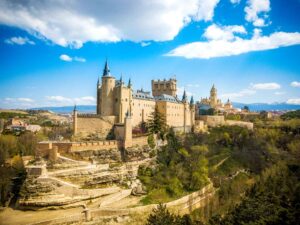
The Alcazaba of Málaga is one of the historical sites, located in Spain, is a historic fortress that offers tourists a glimpse into the city’s rich Moorish heritage.
Built in the 11th century by the Hammudid dynasty, the Alcazaba is a stunning example of Moorish architecture and is one of the best-preserved Islamic fortresses in Spain.
Visitors to the Alcazaba of Málaga can explore its impressive walls, towers, and gardens; moreover, these features offer panoramic views of the city and the Mediterranean Sea.
The builders divided the fortress into three main areas: the lower precinct, the intermediate precinct, and the upper precinct.
Each area features intricate stonework, beautiful courtyards, and lush gardens that transport visitors back in time to the era of Moorish rule in Spain.
One of the highlights of a visit to the Alcazaba is the Nasrid Palace, a beautifully preserved palace complex that showcases the intricate tile work, arches, and fountains typical of Moorish architecture.
Visitors can wander through the palace’s ornate rooms and courtyards; in addition, they can marvel at the craftsmanship and attention to detail that went into its construction.
For tourists looking to learn more about the history of the Alcazaba and its significance in Málaga’s past, guided tours are available in multiple languages.
These tours provide insight into the fortress’s history, architecture, and the daily life of its inhabitants during the Moorish period.
Its stunning beauty, historical significance, and picturesque setting make it a truly unforgettable experience for visitors to the city of Málaga.






